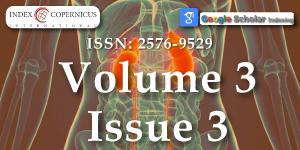A pilot study on treatment of infantile cystinosis with mesenchymal stem cells
Main Article Content
Abstract
Infantile cystinosis is a lysosomal storage disease leading to end stage kidney disease at early ages. There is no effective treatment and patients require long term dialysis or kidney transplant for survival. We present our experience on three affected children who received HLA matched allogeneic stem cell transplant. The protocol used was novel and designed to promote engraftment. The primary endpoint was safety for treatment related mortality or morbidity; All three children survived without serious adverse effects during extended follow up for over 4 years. Although we could not prove engraftment, all three children met secondary end point of sustained target functions over a 6 month follow-up. Further studies are warranted to further evaluate safety and efficacy of MSC treatment for infantile cystinosis.
Article Details
Copyright (c) 2019 Gok F, et al.

This work is licensed under a Creative Commons Attribution 4.0 International License.
Ruivo R. Anne C, Sagne C, Gasnier B. Molecular and cellular basis of lysosomal transmembrane protein dysfunction. Biochem Biophys Acta. 2009; 1793: 636–649. PubMed: https://www.ncbi.nlm.nih.gov/pubmed/19146888
Sansanwal P, Sarwal MM. Abnormal mitochondrial autophagy in nephropathic cystinosis. Autophagy. 2010; 6: 971-973. PubMed: https://www.ncbi.nlm.nih.gov/pubmed/20729635
Anikster Y, Shotelersuk V, Gahl WA. CTNS mutations in patients with cystinosis. Hum Mutat. 1999; 14: 454–458. PubMed: https://www.ncbi.nlm.nih.gov/pubmed/10571941
Attard M, Jean G, Forestier L, Cherqui S, van't Hoff W, et al. Severity of phenotype in cystinosis varies with mutations in the CTNS gene: predicted effect on the model of cystinosin. Hum Mol Genet. 1999; 8: 2507–2514. PubMed: https://www.ncbi.nlm.nih.gov/pubmed/10556299
Gahl WA, Thoene JG, Schneider JA. Cystinosis. New Engl J Med. 2002; 347: 111–121. PubMed: https://www.ncbi.nlm.nih.gov/pubmed/12110740
Goldman H, Scriver CR, Aaron K, Delvin E, Canlas Z. Adolescent cystinosis: comparisons with infantile and adult forms. Pediatrics. 1971; 47: 979–988. PubMed: https://www.ncbi.nlm.nih.gov/pubmed/5141767
Cogan DG, Kuwabara T, Kinoshita J, Sheehan L, Merola L. Cystinosis in an adult. J Am Med Assoc. 1957; 164: 394–396. PubMed: https://www.ncbi.nlm.nih.gov/pubmed/13415995
Brodin-Sartorius A, Tete MJ, Niaudet P, Antignac C, Guest G, et al. Cysteamine therapy delays the progression of nephropathic cystinosis in late adolescents and adults. Kidney Int. 2012; 81: 179–189. PubMed: https://www.ncbi.nlm.nih.gov/pubmed/21900880
Rocca CJ, Cherqui S. Potential use of stem cells as a therapy for cystinosis. Pediatr Nephrol. 2019; 34: 965-973. PubMed: https://www.ncbi.nlm.nih.gov/pubmed/29789935
Cahill RA, Jones OY, Klemperer M, Steele A, Mueller TO, et al. Replacement of recipient stromal/mesenchymal cells after bone marrow transplantation using bone fragments and cultured osteoblast-like cells. Biol Blood Marrow Transplant. 2004; 10: 709-717. PubMed: https://www.ncbi.nlm.nih.gov/pubmed/15389437
Syres K, Harrison F, Tadlock M, Jester JV, Simpson J, et al. Successful treatment of the murine model of cystinosis using bone marrow cell transplantation. Blood. 2009; 114: 2542–2552. PubMed: https://www.ncbi.nlm.nih.gov/pubmed/19506297
Iglesias DM, El-Kares R, Taranta A, Bellomo F, Emma F, et al. Stem Cell Microvesicles Transfer Cystinosin to Human Cystinotic Cells and Reduce Cy stine Accumulation In vitro. PLoS One. 2012; 7: e42840. PubMed: https://www.ncbi.nlm.nih.gov/pubmed/22912749

